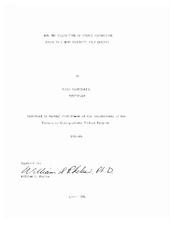| dc.contributor.advisor | Rholes, William S. | |
| dc.creator | Vanderweide, Vicki | |
| dc.date.accessioned | 2022-06-30T16:13:43Z | |
| dc.date.available | 2022-06-30T16:13:43Z | |
| dc.date.issued | 1986 | |
| dc.identifier.uri | https://hdl.handle.net/1969.1/CAPSTONE-VanderweideV_1986 | |
| dc.description | Program year: 1985-1986 | en |
| dc.description | Digitized from print original stored in HDR | en |
| dc.description.abstract | The purpose of this study was to examine the relationship between the understanding of stable dispositions and the development of a realistic self-concept. It was hypothesized that once children have acquired the understanding that traits and abilities are stable over time they will then have a more realistic self-concept. To examine whether children understand the stability of dispositions, they were given the Stable Dispositions Concept (SDC) measurement. Forty-three children ranging in age from 5 to 10 years were used for the study because of the indications that children begin to acquire SDC about 7 or 8 years. A secondary concern was to examine the relationship of gender constancy and SDC. The results of the study did not support the primary hypothesis. However, findings from previous studies were confirmed, and the SDC was validated. A discussion of these results and a suggestion for further research were also presented. | en |
| dc.format.extent | 43 pages | en |
| dc.format.medium | electronic | en |
| dc.format.mimetype | application/pdf | |
| dc.subject | self-concept | en |
| dc.subject | childhood psychology | en |
| dc.subject | stable dispositions | en |
| dc.subject | gender | en |
| dc.title | How the Acquisition of Stable Disposition Leads to a More Realistic Self-Concept | en |
| dc.type | Thesis | en |
| thesis.degree.department | Psychology | en |
| thesis.degree.grantor | University Undergraduate Fellows | en |
| thesis.degree.level | Undergraduate | en |
| dc.type.material | text | en |


